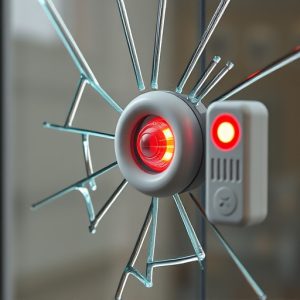Secure Your Premises: A Comprehensive Guide to Installing and Maintaining Glass Break Alarm Sensors
Glass break alarm sensors are integral components of modern home security systems, effectively dete…….
Glass break alarm sensors are integral components of modern home security systems, effectively detecting the sound of breaking glass and promptly triggering alarms to alert occupants or security services of potential intrusions. These sensors rely on advanced microphone technology to distinguish between the acoustic signature of glass breakage and other household sounds, minimizing false alarms. Their placement and configuration must be tailored to the specific architecture and noise levels of your home, ensuring they are out of reach for tampering and have clear lines of sight to all vulnerable glass areas. Proper installation is crucial and involves careful adherence to the manufacturer's manual, precise positioning, and integration with your existing security system. Regular testing and maintenance are necessary to confirm their sensitivity and accuracy, ensuring they remain a reliable deterrent against unauthorized entry. For optimal performance, glass break alarm sensors should be kept clean and free of obstructions, and battery life must be monitored and addressed regularly. These sensors play a pivotal role in fortifying homes, providing homeowners with heightened protection and peace of mind.
When securing your premises, a glass break alarm sensor offers a sophisticated layer of defense against intrusion. This article delves into the technology behind these innovative sensors and provides a comprehensive guide to their installation. From understanding how they detect the sound of breaking glass to considering environmental factors, we cover essential aspects before installation. Then, with a detailed step-by-step process, we guide you through setting up your own system. Additionally, we offer insights on optimal placement and testing methods, as well as maintenance tips and solutions to common issues. Enhance your home or business security with the informed use of glass break alarm sensors.
Understanding the Glass Break Alarm Sensor Technology
Glass break alarm sensors represent a critical component in the arsenal of home security systems, providing a prompt response to the potential threat of intrusion. These sophisticated devices are engineered to detect the unique acoustic signature of glass breaking, distinguishing it from other sounds such as windows rattling in the wind or doors slamming shut. The technology hinges on microphones that are highly sensitive and finely tuned to identify the frequency patterns typical of shattered glass. Upon activation, a glass break alarm sensor can instantly trigger an audible or visual alarm signal, alerting homeowners or security personnel of a potential breach. This early warning system is invaluable in deterring burglars, as the sound of activated alarms can be a powerful deterrent. Additionally, the integration of these sensors within a broader smart home security network enables seamless communication with other devices, enhancing overall system efficiency and responsiveness. Users can rest assured that with a glass break alarm sensor installed, their property’s vulnerabilities to forced entry are significantly mitigated.
Factors to Consider Before Installing a Glass Break Alarm System
When considering the installation of a glass break alarm system, several technical and environmental factors merit attention to ensure optimal functionality and security. Firstly, the layout and architecture of your premises will influence the type and number of glass break alarm sensors required. Factors such as window size, material thickness, and ambient noise levels can affect the sensitivity settings needed for accurate detection. It’s crucial to assess these variables to select sensors that can discern between potential threats and benign sounds like construction or weather events. Additionally, the placement of sensors is a critical aspect of the installation process; they should be positioned where they have a clear line of sight to potential glass points of entry without being in reach of tampering. The chosen sensors must also integrate seamlessly with your existing security system, ensuring a cohesive and coordinated response upon activation. Furthermore, the proximity of the alarm system to these potential breach points and the configuration of the surrounding area can impact signal range and detection efficiency. To ensure the glass break alarm sensor operates effectively, professional installation is often recommended, as it allows for precise calibration and positioning to protect against unauthorized entry while minimizing false alarms.
Step-by-Step Guide to Installing a Glass Break Alarm Sensor
To effectively install a glass break alarm sensor, one must follow a detailed, systematic approach. Begin by carefully reading the manufacturer’s manual to understand the specific model’s requirements and safety precautions. The installation process typically starts with selecting an appropriate location for the sensor. This spot should be near potential points of entry and within the line of sight of vulnerable glass panels. Once the optimal location is determined, affix the sensor securely to the wall or ceiling using the provided mounting hardware, ensuring it’s placed at a height where it can detect vibrations from impact or breakage.
After securing the sensor, the next step involves connecting it to the main control panel of your glass break alarm system. Use the supplied wires to link the sensor to the panel, and follow the instructions for proper connection. It’s crucial to ensure that all connections are tight but not overly tight as to damage the components. Following connection, power on the system and test the sensor by simulating a window being broken near its range. The alarm should activate, confirming that the sensor is correctly installed and functioning. Finally, for optimal performance and coverage, consider placing additional sensors in different areas where valuable glass panels are located, such as patio doors or display cases. Remember to keep the sensor clean and free from obstructions for uninterrupted surveillance and detection.
Best Practices for Positioning and Testing Your Glass Break Alarm Sensors
When installing a glass break alarm sensor, careful consideration of its positioning is paramount to ensure optimal detection and minimal false alarms. The sensor should be placed where it has an unobstructed view of windows and doors that are susceptible to forced entry. A common best practice is to mount the sensors at a height of 5 to 6 feet, just above the window or door frame, as this is where most glass break attempts occur. Additionally, the sensors should be installed away from any obstructions such as curtains, blinds, or air conditioning units that could potentially interfere with their sensitivity.
Upon installation, it is crucial to test each sensor to confirm its functionality and coverage area. This can be done by playing a recording of a breakage sound specific to glass shattering, which the sensor has been pre-calibrated to detect. The volume at which the sensor responds will determine if additional sensors are needed or if repositioning is necessary for better coverage. It is also advisable to test the system in different weather conditions, as temperature fluctuations can sometimes affect the sensitivity of glass break alarm sensors. Regular testing, along with maintenance checks, will help ensure that your glass break alarm system remains a reliable layer of security for your property.
Maintenance and Troubleshooting Common Issues with Glass Break Alarm Systems
When maintaining a glass break alarm system, regular checks are essential to ensure its optimal performance and reliability. Homeowners and security personnel should test the sensor’s functionality periodically by simulating the sound of breaking glass within the detection range. This process verifies whether the sensor accurately distinguishes between typical household noises and the specific acoustic signature of glass breakage. Additionally, it’s crucial to keep the sensor clean and unobstructed, as dirt or obstructions can interfere with its sensitivity and accuracy. If the system fails to activate upon simulated breakage, troubleshooting should begin by inspecting the sensor for any signs of dust, debris, or damage, and clearing them if present.
Troubleshooting common issues with glass break alarm sensors often involves examining the system’s connection to the central control panel. A loose or faulty wire can disrupt communication and lead to false negatives or missed detections. If the sensor is functioning correctly but not communicating with the panel, checking the wiring connections and ensuring they are secure can resolve the issue. Another common problem is battery failure within the sensor unit. Regularly changing the batteries according to the manufacturer’s guidelines helps prevent power outages that could disable the sensor. In cases where the system continues to malfunction after these initial troubleshooting steps, consulting the user manual or contacting a professional for further assistance is advisable. Understanding the glass break alarm sensor’s maintenance and common troubleshooting issues empowers users to ensure their system remains a robust line of defense against intrusion attempts.


